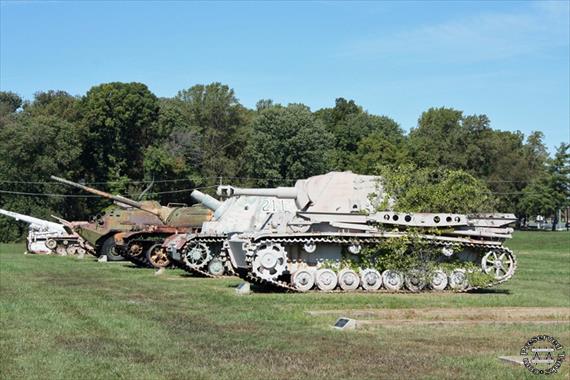
|
|
Location Category ID:
|
70050
|
|
Added to Database:
|
May 2008
|
|
Last Edited:
|
5 January 2014
|
|
Address: |
United States Army Ordnance Museum, Aberdeen Boulevard, Aberdeen Proving Ground, Maryland
|
|
Telephone: |
410-278-3602
|
|
Email: |
|
|
Opening Times: |
9.00am – 4.45pm daily, closed National Holidays except Armed Forces, Memorial, Independence and Veterans’ Days. Request Day Pass at Maryland Avenue Gate.
|
|
Official Website: |
The U.S. Army Ordnance Museum
|
|
Other Links: |
Ordnance Museum Foundation
Wikipedia
|
|
Latitude, Longitude: |
39.490794
,
-76.14255
|
|
Location Accuracy: |
7
|
|
Tanks Previously Here: |
1: Panzerjäger I Tank Destroyer - BWB Wehrtechnische Studiensammlung, Koblenz, Koblenz District, Rhineland-Palatinate, Germany (Part of APG collection)
2: Panzerkampfwagen II Tank - National Armor and Cavalry Museum, Fort Benning, Muscogee County, Georgia, USA (1940s-1989)
3: Marder II Tank Destroyer - National Armor and Cavalry Museum, Fort Benning, Muscogee County, Georgia, USA (1940s-1989)
4: Wespe Self-Propelled Howitzer - BWB Wehrtechnische Studiensammlung, Koblenz, Koblenz District, Rhineland-Palatinate, Germany (Estimated 1940s-early 1980s)
5: Sturmgeschütz III Assault Gun - Panzermuseum, Munster, Soltau-Fallingbostel, Lower Saxony, Germany (From 1945)
6: Sturmhaubitze 42 Assault Gun - U.S. Army Artillery Museum, Fort Sill, Lawton, Oklahoma, USA (Until November 2012)
7: Panzerkampfwagen IV Tank - Patton Museum of Cavalry and Armor, Fort Knox, Kentucky, USA (Until transferred)
8: Hummel Self-Propelled Howitzer - Panzermuseum, Munster, Soltau-Fallingbostel, Lower Saxony, Germany (Until 1946)
9: Hummel Self-Propelled Howitzer - U.S. Army Artillery Museum, Fort Sill, Lawton, Oklahoma, USA (Until 1946)
10: Waffenträger leFH 18/1 auf GW IVb Weapon Carrier - U.S. Army Artillery Museum, Fort Sill, Lawton, Oklahoma, USA (Until ca November 2012)
11: Sturmpanzer IV Brummbär Assault Gun - U.S. Army Artillery Museum, Fort Sill, Lawton, Oklahoma, USA (Until ca November 2012)
12: Panther II Tank - National Armor and Cavalry Museum, Fort Benning, Muscogee County, Georgia, USA (About 1945)
13: Tiger Tank - Wheatcroft Collection, Leicester, Leicestershire, East Midlands, Britain (1943-1989)
14: Sturmtiger Assault Gun - Panzermuseum, Munster, Soltau-Fallingbostel, Lower Saxony, Germany (Estimated 1940s-1970s)
15: Tiger II Tank - Panzermuseum, Munster, Soltau-Fallingbostel, Lower Saxony, Germany (Until December 1960)
16: Tiger II Tank - National Armor and Cavalry Museum, Fort Benning, Muscogee County, Georgia, USA (Until September 1991)
17: 15cm sIG 33 Grille Self-Propelled Howitzer - U.S. Army Artillery Museum, Fort Sill, Lawton, Oklahoma, USA (Until ca 2010)
18: Marder I Tank Destroyer - Museé Des Blindés, Saumur, Anjou, Maine-et-Loire, France (Captured 1944)
19: MBT-70 Tank - Military Museum of Southern New England, Danbury, Fairfield County, Connecticut, USA (Until ca1990s)
20: XM800 ARSV-T Light Tank - Military Museum of Southern New England, Danbury, Fairfield County, Connecticut, USA (Dates unknown)
21: T92 Howitzer Motor Carriage - U.S. Army Artillery Museum, Fort Sill, Lawton, Oklahoma, USA (Until ca 2010)
22: Type 65 Self-Propelled Gun - U.S. Army Artillery Museum, Fort Sill, Lawton, Oklahoma, USA (Until ca 2012)
23: T-54A Tank - National Armor and Cavalry Museum, Fort Benning, Muscogee County, Georgia, USA (Until loaned out)
24: Semovente M41M da 90/53 Assault Gun - U.S. Army Artillery Museum, Fort Sill, Lawton, Oklahoma, USA (Until ca 2012)
25: Semovente da 149/40 Assault Gun - U.S. Army Artillery Museum, Fort Sill, Lawton, Oklahoma, USA (Until November 2010)
26: Schneider Tank - Museé Des Blindés, Saumur, Anjou, Maine-et-Loire, France (Seen in 1983 but gone by 2001)
27: Saint Chamond Tank - Museé Des Blindés, Saumur, Anjou, Maine-et-Loire, France (Seen in 1983 but gone by 2001)
28: Canon de 194 mle GPF Self-Propelled Howitzer - U.S. Army Artillery Museum, Fort Sill, Lawton, Oklahoma, USA (Until ca 2012)
|
[Note: As a result of the BRAC ‘base realignment’ process a large proportion of the vehicles at APG have been transferred to other bases and museums. This listing was originally compiled during the 1980s and is being updated in line with the changes that have taken place. In the meantime if you are planning to visit APG you should contact the base for the latest information first, particularly regarding any security restrictions on visitors.]
The U.S. Army Ordnance Museum, at Aberdeen Proving Ground, is located approximately half-way between Baltimore and Philadelphia and can be reached from either by following Interstate 95 (the Kennedy Highway) or Route 40 (the Pulaski Highway). It originated with the Calibre Board of 1918. This was convened in France to evaluate the lessons learned in World War I regarding the use of artillery and to make recommendations about future policies concerning its development by the U.S. Army. To do this all kinds of artillery equipment were shipped to Aberdeen Proving Ground for technical evaluation. A repository was organised there to store and catalogue the various items acquired from France and other sources. In the 1920s the decision was made to expand the museum's collection from purely artillery equipment to include small arms, military vehicles and armoured fighting vehicles, aircraft bombs and fire-control equipment.
The collection continued to grow until 1940 when the U.S. Armed Forces were rapidly expanded and the museum building was taken over for classroom use. The collection was stored out of doors where it quickly deteriorated until most of it was scrapped in 1942. In September of the same year a Foreign Materiel Section was established to study and report on foreign equipment, enormous amounts of which were forwarded to Aberdeen for evaluation and later became the nucleus of the post-war museum collection. The Foreign Materiel Board was disestablished soon after the end of hostilities but the museum section survived and became known as the Aberdeen Proving Ground Museum.
In 1962 when the U.S. Army underwent a major reorganisation the museum became an element of the U.S. Army Ordnance Center and School. Its purpose was to support the various courses on Ordnance offered to military students and to use its collection to support Department of Defense research and development projects and intelligence studies.
|